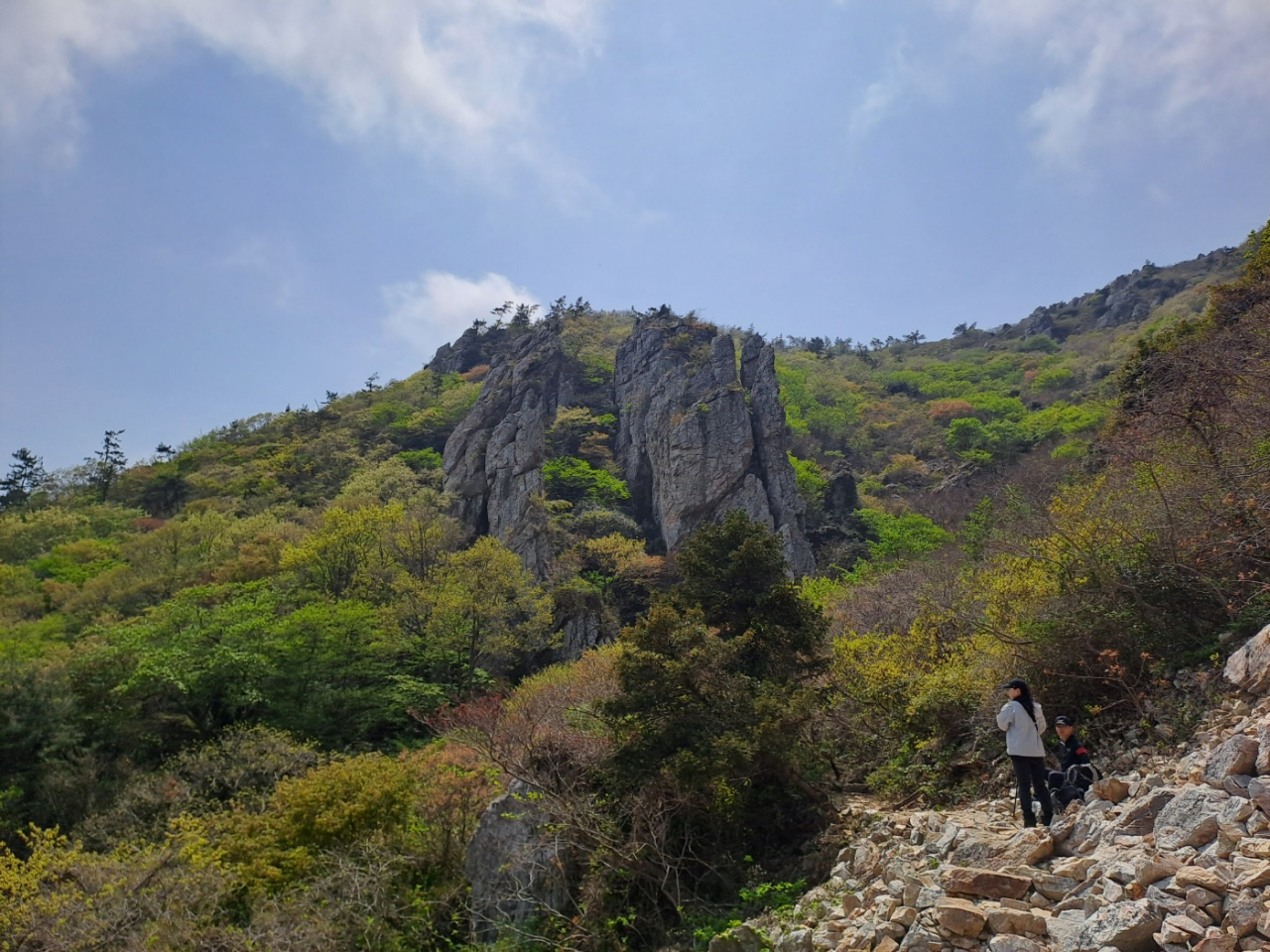 |
Hikers take a rest along a rock-covered slope or "neodeol" along Dalmasan Trail in Haenam, South Jeolla Province, on April 16. (Lee Si-jin/The Korea Herald) |
HAENAM, South Jeolla Province -- Haenam, some 400 kilometers south of Seoul, is famous for its Ttangkkeut village at the southernmost tip of the Korean Peninsula. The village gets crowded with visitors who wish to watch the last sunset or the first sunrise of the year. The village is especially crowded on Dec. 31.
But the county’s 17.74-kilometer walking trail has recently gotten on the radar of hiking and walking enthusiasts, as it presents opportunities for memorable outdoor activities surrounded by the beautiful nature of Dalmasan, a mountain with a unique stamp tour.
Dalmasan Dulegil -- which means "Dalmasan circular trail" in Korean -- and is also known as Dalmagodo, was the historical pilgrimage route supposedly taken by Buddhist monks of the mountain’s 12 ancient temples.
The trail is considered one of Korea's most nature-friendly walking paths. Almost 10,000 people worked without the use of heavy equipment, machinery, wooden decks or paving to restore the trail without damaging its original state and for people to walk easily around Dalmasan.
Named after the different stages of becoming a Buddhist monk, the four sections of the trail are called “chulga,” “suhaeng,” “gohaeng” and “haetal,” meaning leaving home to join a monastic order, ascetic practice, suffering and attaining enlightenment, respectively.
The time it takes to complete the entire trail might vary, but Haenam county suggests Dalmasan Trail requires 6 1/2 hours.
The county replaced old-fashioned ink-based stamps and pads with QR codes for the stamp tour starting on Feb. 2. Visitors now need to complete a quick verification by registering their names and phone numbers.
Don’t forget to stop by the bathroom before setting off on your hike, because there are no toilets on the trail.
A total of six digital stamps and a selfie taken while hiking are required to complete the Dalmasan Trail stamp tour.
Chulga-gil
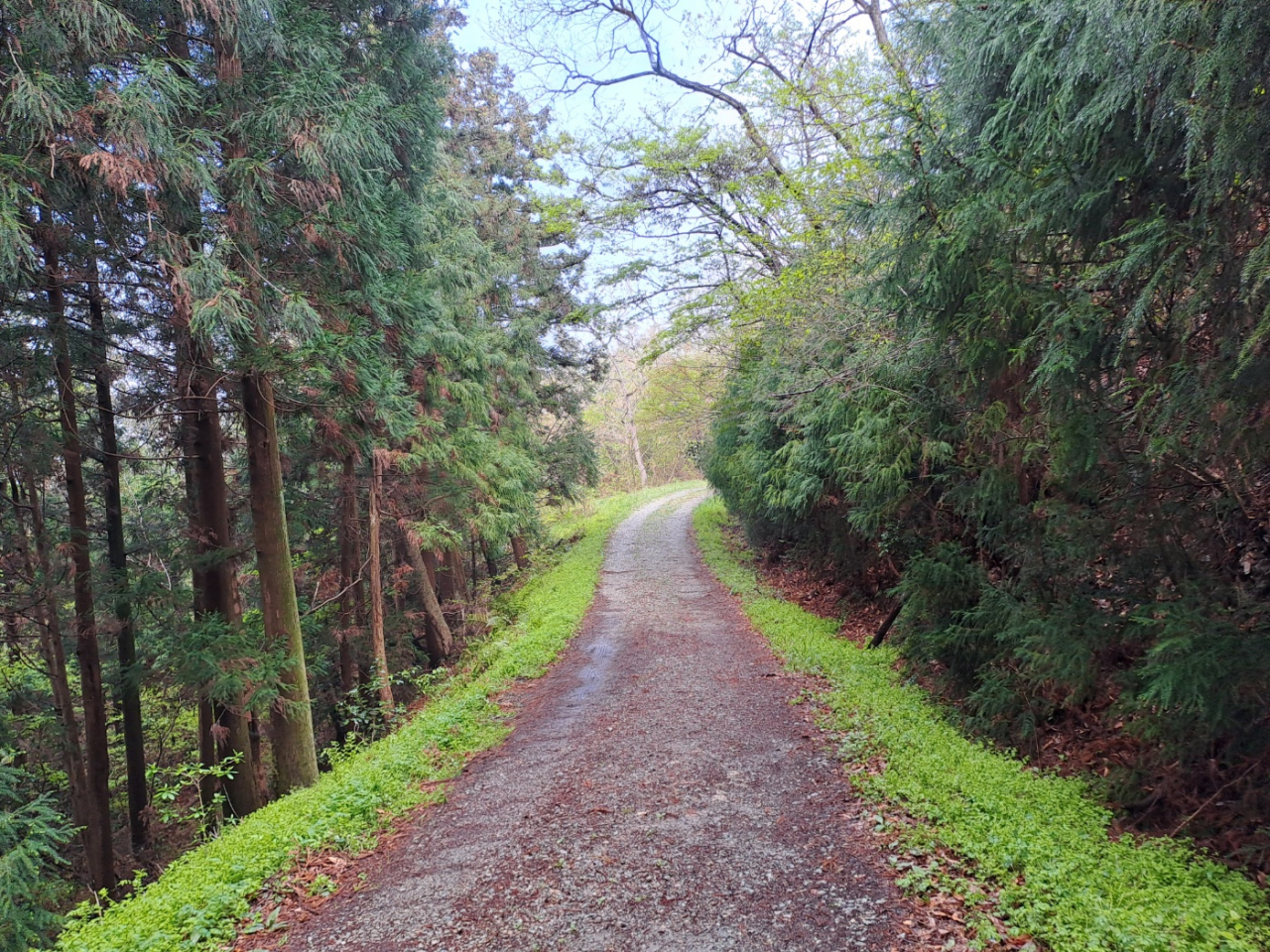 |
Dalmasan Trail's Chulga-gil (Lee Si-jin/The Korea Herald) |
Dalmasan Trail begins at the entrance of Mihwangsa Temple, known as Cheonwangmun, or "Heavenly Kings Gate" in Korean.
After walking through the gate, visitors should look for a wooden, mailbox-shaped locker, where maps of the trail are stored. A banner reminds hikers that they need to have enough water, charged their smartphone battery and to turn on their GPS to begin the tour.
The 2.71-kilometer Chulga-gil is an easy, mostly dirt, walking path.
The lush forest of various trees, including cherry trees, sawtooth oaks, East Asian eurya shrubs and more, provide cool shade from the strong sun and form a nice umbrella when it rains.
A gentle slope appears at the end of the first section, but it will not make anyone feel as if they were doing strenuous hiking.
Beginner hikers do not need to worry about getting lost in the forest as stone signs are installed every 500 meters. Red, yellow and blue ribbons, which have been tied to the trees by local mountain climbing clubs, are another sign to check that you are headed in the right direction.
As soon as you exit the forest and encounter a pebble-covered road, you will reach a wide open area called “Keunbaramjae,” meaning "a mountain ridge where the wind blows hard" in Korean.
Suhaeng-gil
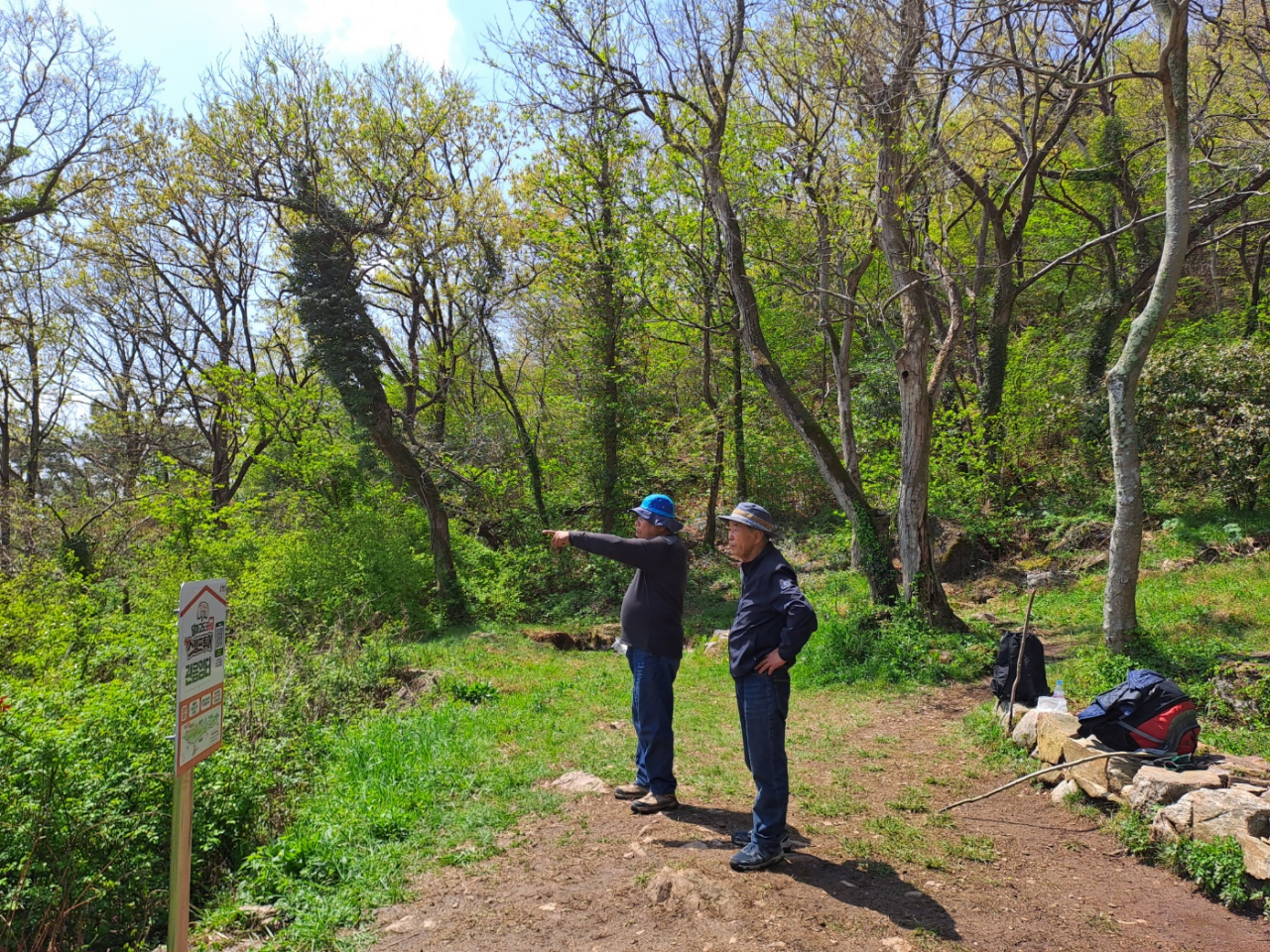 |
Hikers rest at the old Buddhist hermitage site of Gwaneumam on April 16. (Lee Si-jin/The Korea Herald) |
Many consider Suhaeng-gil, the second part of the trail, to be the real starting point of Dalmasan Trail.
Here, the trail gets narrow and the incline gets a little steep.
Some stones, which make the visitors stare at the ground time to time, start to appear on the clean dirt path as well.
The uphills and downhills start to "entertain" hikers, who might have been disappointed by the flatter, monotonous earlier part of the trail.
A total of three QR codes can be scanned along Suhaeng-gil.
Two are at old Buddhist hermitage sites where Gwaneumam and Munsuam stood in the early Joseon era (1392-1910).
The path between the two old small temples is considered the most beautiful part of the entire Dalmasan Trail. You can hear the chirping of birds on the right side of the walking trail, while feasting your eyes on the scenic coastal view, countless islands in the southern sea and the seemingly endless horizon on your left.
The second part of the 4.73-kilometer Suhaeng-gil features “neodeol,” or "rock-covered slopes" in Korean.
Those walking the trail will see a river of stones that seems to run from the top of the mountain to the sea.
Offering a mesmerizing view of the landscape with its mountain ridges punctuated by peculiar-looking rock outcroppings and peaks that stretch over 7 kilometers, the neodeol are popular resting areas for exhausted hikers.
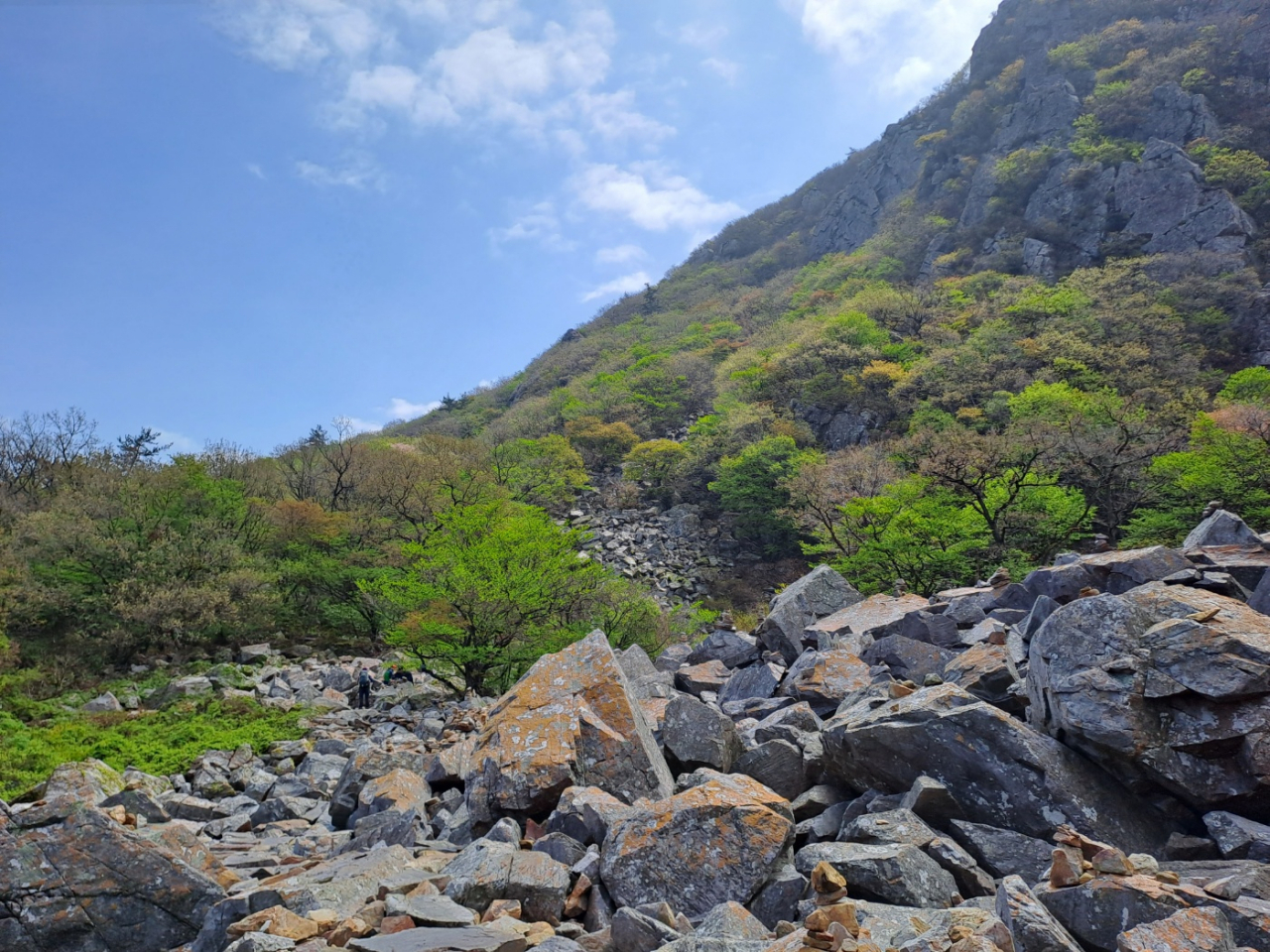 |
Dalmasan Trail's neodeol (Lee Si-jin/The Korea Herald) |
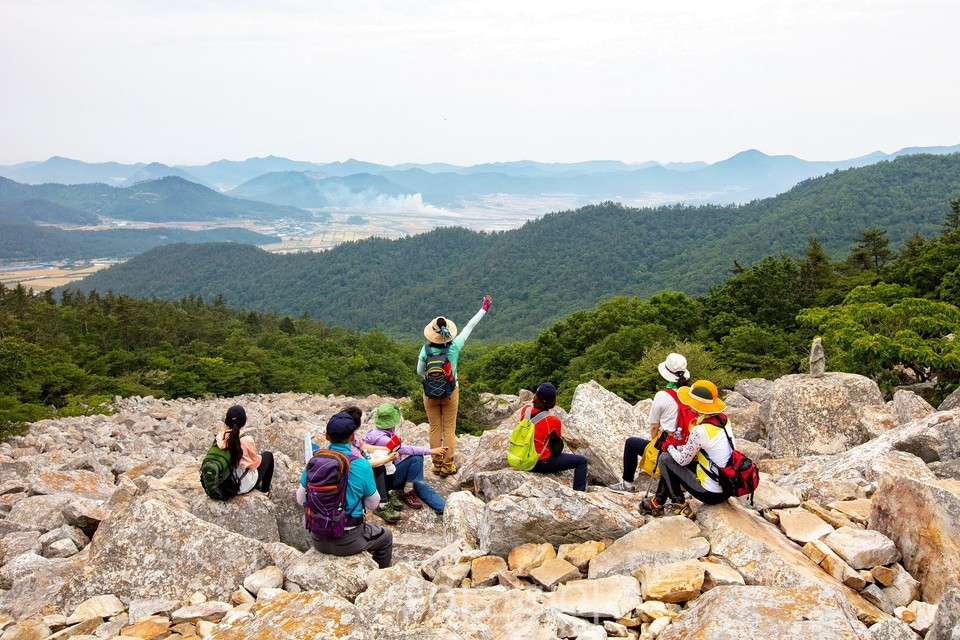 |
Visitors enjoy a panoramic mountain view from a neodeol portion of the trail. (Haenam County) |
The third QR code stamp signals the end of the 4.73-kilometer Suhaeng-gil, giving hikers time to prepare for the trail’s hardest section.
Gohaeng-gil
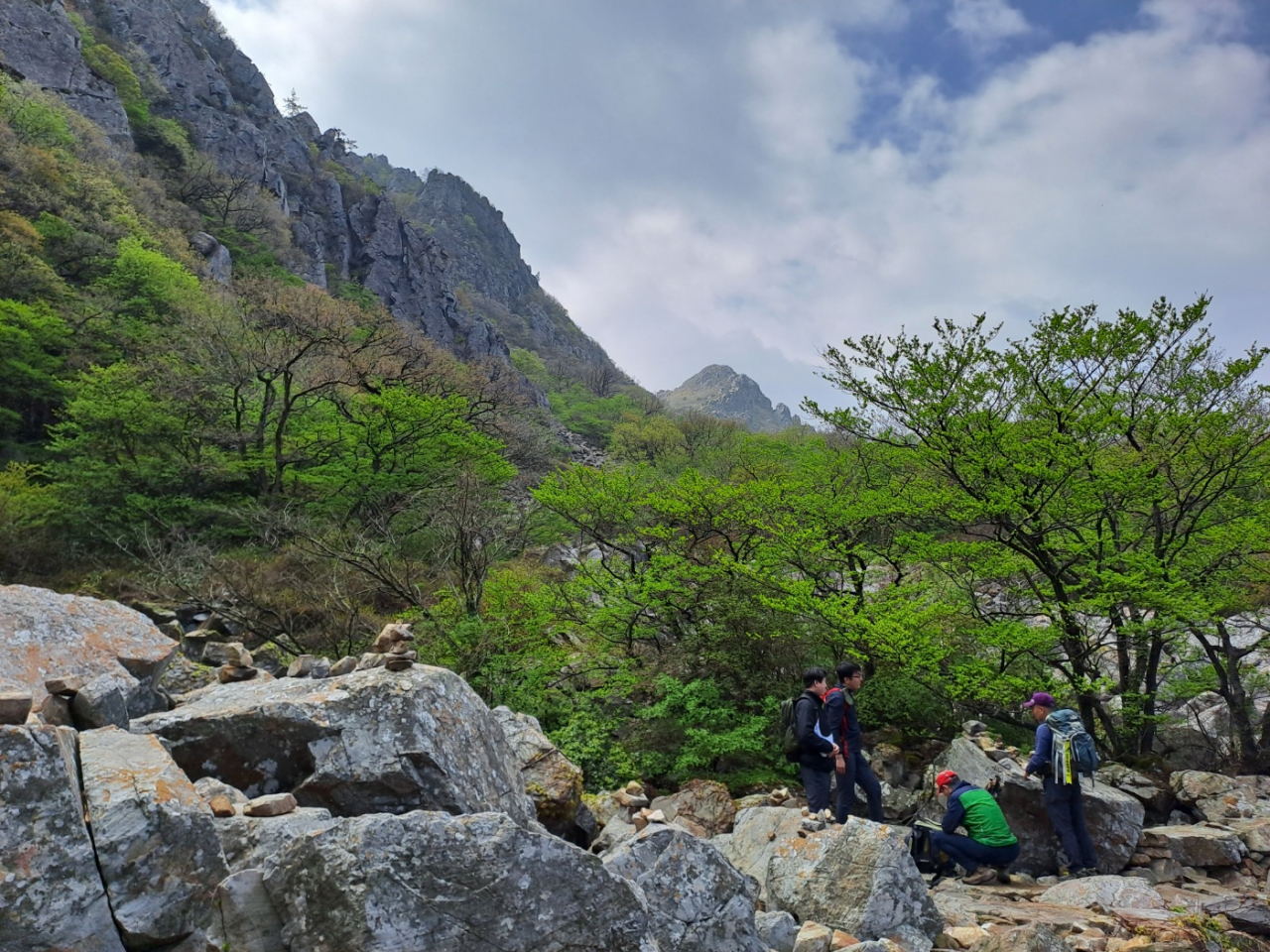 |
Hikers take a break along Gohaeng-gil on April 16. (Lee Si-jin/The Korea Herald) |
The 5.63-kilometer Gohaeng-gil is where the real test begins.
The scenic mountainscapes, lush forest and splendid coastal views remain the same. But visitors must now stop to catch their breath more frequently and stare down at the ground instead of enjoying the view.
Some insist that the third part is the hardest course among the four, because Gohaeng-gil is the longest section. But others believe they get worn out because the trail has many uphill parts.
While neodeol appear along Gohaeng-gil as in the second part of the trail, the path is much narrower with a cliff on the left side. Visitors are also exposed to the sun a lot more as this part of the trail does not have many tree tunnels.
But the trees swaying in the spring breeze create an amazing sound similar to low tide, providing a unique experience along the trail.
Though the path is not covered with wooden decking and has a lot of large rocks, visitors do not need to worry about bringing trekking poles, because the entirety of Dalmasan Trail can be walked without any special hiking equipment.
Hikers can earn two stamps along Gohaeng-gil: one stamp in the middle of the course and another stamp at the end.
Haetal-gil
Having completed three sections, all you have to do now is simply enjoy the fresh, green forest of cedar trees.
Hikers no longer need to worry about sharp rocks, narrow paths or inclines. The area is even considered a running section by some passionate outdoor sports lovers.
Medium-sized cedar trees provide enough shade to cool down from the journey.
Visitors who are not doing the stamp tour may choose to walk only the last section to enjoy the beautiful nature of Dalmasan. Just start at the end of the circular trail.
It is not hard to find seniors or families with children on this last section of Dalmasan Trail.
After a 50-minute walk from the starting point of Haetal-gil, the last QR code sign welcomes hikers doing the stamp tour.
The trail ends on the right side of Mihwangsa Temple, where you can choose to walk around the temple, climb farther up Dalmasan or return to the parking lot.
After collecting the six digital stamps, you can submit them to the Haenam County Office online with your home address.
The county’s tourism department will award the journey with a certificate and a special souvenir, which will arrive in two to three weeks.
This article is the sixth in a series introducing destinations for eco-friendly travel experiences in South Korea. -- Ed.
 |
Digital stamps from Dalmasan Trail (Lee Si-jin/The Korea Herald) |






![[Today’s K-pop] Blackpink’s Jennie, Lisa invited to Coachella as solo acts](http://res.heraldm.com/phpwas/restmb_idxmake.php?idx=644&simg=/content/image/2024/11/21/20241121050099_0.jpg)
